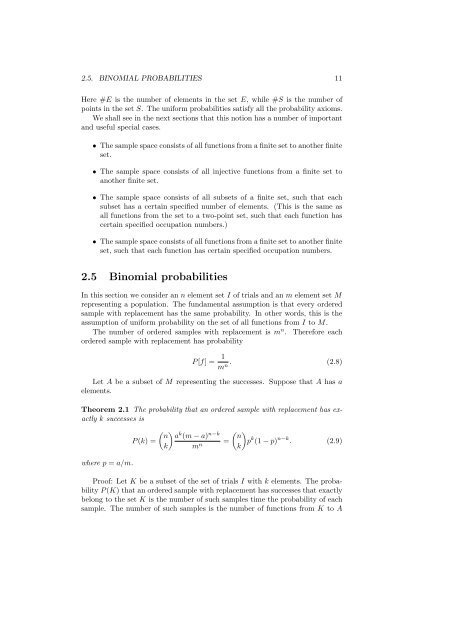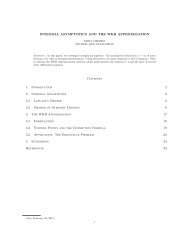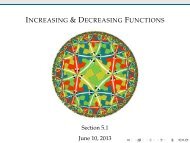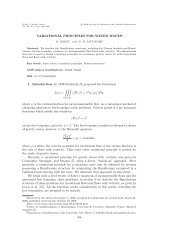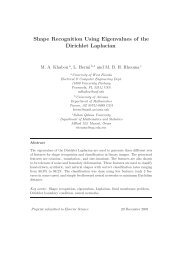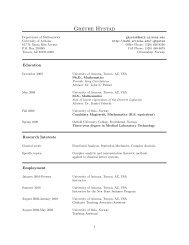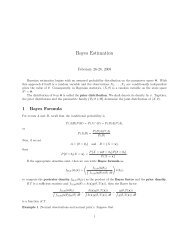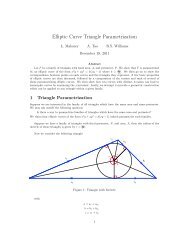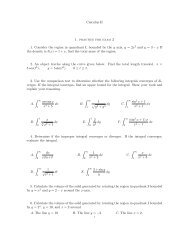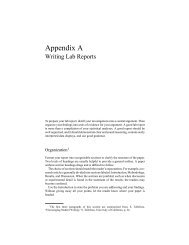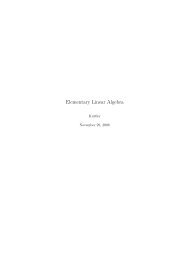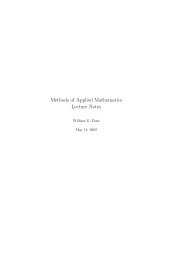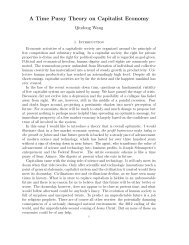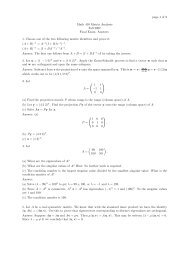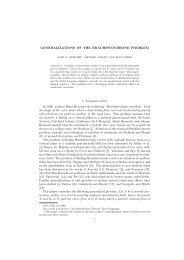Lectures on Elementary Probability
Lectures on Elementary Probability
Lectures on Elementary Probability
You also want an ePaper? Increase the reach of your titles
YUMPU automatically turns print PDFs into web optimized ePapers that Google loves.
2.5. BINOMIAL PROBABILITIES 11<br />
Here #E is the number of elements in the set E, while #S is the number of<br />
points in the set S. The uniform probabilities satisfy all the probability axioms.<br />
We shall see in the next secti<strong>on</strong>s that this noti<strong>on</strong> has a number of important<br />
and useful special cases.<br />
• The sample space c<strong>on</strong>sists of all functi<strong>on</strong>s from a finite set to another finite<br />
set.<br />
• The sample space c<strong>on</strong>sists of all injective functi<strong>on</strong>s from a finite set to<br />
another finite set.<br />
• The sample space c<strong>on</strong>sists of all subsets of a finite set, such that each<br />
subset has a certain specified number of elements. (This is the same as<br />
all functi<strong>on</strong>s from the set to a two-point set, such that each functi<strong>on</strong> has<br />
certain specified occupati<strong>on</strong> numbers.)<br />
• The sample space c<strong>on</strong>sists of all functi<strong>on</strong>s from a finite set to another finite<br />
set, such that each functi<strong>on</strong> has certain specified occupati<strong>on</strong> numbers.<br />
2.5 Binomial probabilities<br />
In this secti<strong>on</strong> we c<strong>on</strong>sider an n element set I of trials and an m element set M<br />
representing a populati<strong>on</strong>. The fundamental assumpti<strong>on</strong> is that every ordered<br />
sample with replacement has the same probability. In other words, this is the<br />
assumpti<strong>on</strong> of uniform probability <strong>on</strong> the set of all functi<strong>on</strong>s from I to M.<br />
The number of ordered samples with replacement is m n . Therefore each<br />
ordered sample with replacement has probability<br />
P [f] = 1<br />
m n . (2.8)<br />
Let A be a subset of M representing the successes. Suppose that A has a<br />
elements.<br />
Theorem 2.1 The probability that an ordered sample with replacement has exactly<br />
k successes is<br />
where p = a/m.<br />
( n a<br />
P (k) =<br />
k) k (m − a) n−k ( ) n<br />
m n = p k (1 − p) n−k . (2.9)<br />
k<br />
Proof: Let K be a subset of the set of trials I with k elements. The probability<br />
P (K) that an ordered sample with replacement has successes that exactly<br />
bel<strong>on</strong>g to the set K is the number of such samples time the probability of each<br />
sample. The number of such samples is the number of functi<strong>on</strong>s from K to A


